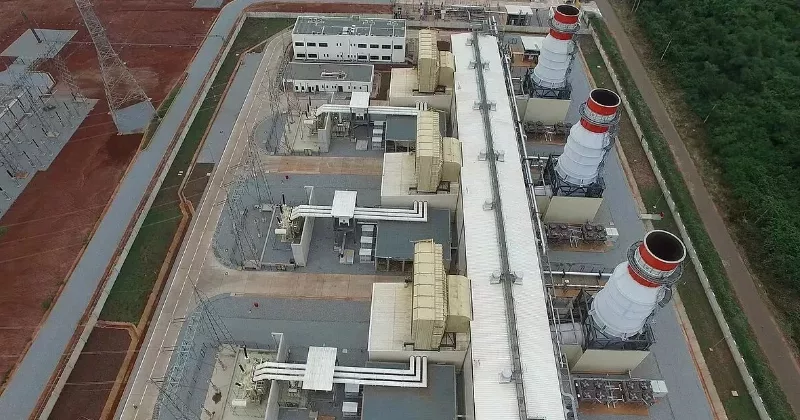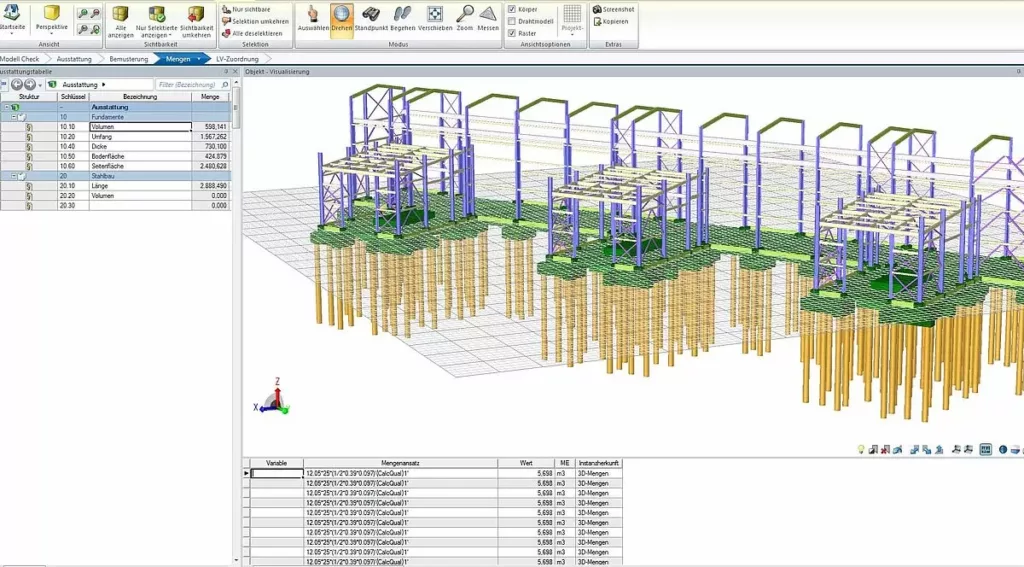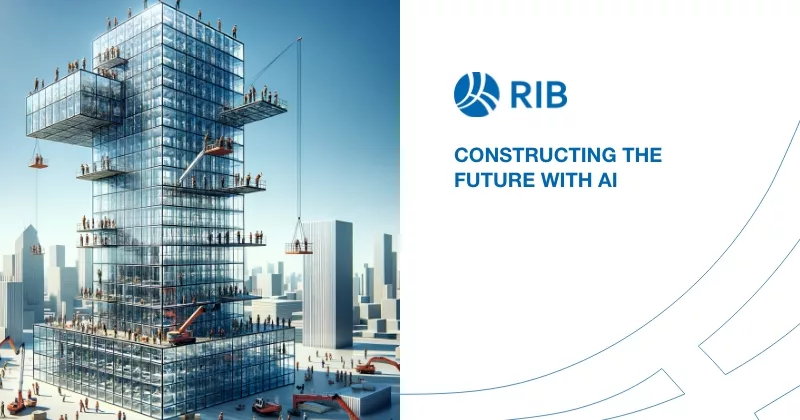6 mins read
Optimized Collaborationat Julius Berger International With BIM 5D
8 mins read

As a general planner, the company, part of the Julius Berger Group, was responsible, in consortium with the Siemens Power and Gas Division, Erlangen, for the planning and construction of the AZURA power plant in Benin City, Nigeria. The complex construction work, an international collaboration, was realized entirely in a model-oriented way, using BIM methods.
Model-Based Planning and Realization of a Gas Power Plant in Nigeria
Julius Berger International GmbH (JBI) has made a name for itself through innovative engineering projects, demanding logistics and extensive service provision in the construction sector. The companies in the Julius Berger Group are responsible, in consortium with the Siemens Power and Gas Division, for the general planning and construction of the AZURA gas power plant in Benin City, Nigeria. Already in 2014, the decision was taken to realize this complex and demanding construction project, carried out in international collaboration with international partners, in a fully model-oriented way using BIM methods (Building Information Modeling). The new-build in Nigeria took shape over a period of 28 months in total. In building phase 1, the turbine hall, for in total three turbines with 150 megawatts of power, and including the required peripheral buildings and infrastructure, was completed.
5d Bim Planning Sustainably Strengthens Collaboration
To create a basis for transparent and trusting collaboration among the planning teams involved, all plan data were imported into the RIB BIM 5D software iTWO already at an early stage of bid processing. In iTWO 5D, in the first stage, the different quantities were checked. Markus Hoffmann, BIM coordinator at JBI, then completed an overall model on the basis of the project partners’ sub-models, which served in all subsequent phases of the project as a coordination model and could also be referred to on site for all project-relevant decisions. Thus, it offered comprehensive support at an early stage of planning in recognizing collisions in the amalgamation of the draft plans from different planners and contributed, in this way, to the frictionless, fault-free execution of the construction. The coordination model, in interplay with the end-to-end software solution RIB iTWO 5D, provided comprehensive support for the partner companies in all further planning and construction phases – from calculation through procurement to controlling. The option of working with a consistent 3D/5D model sustainably strengthened the cooperation of the involved specialist planning disciplines.

The new-build in Nigeria took shape over a period of 31 months in total. In building phase 1, the turbine hall, for in total three turbines with 150 megawatts of power, and including the required peripheral buildings and infrastructure, was completed.
A Shared Platform for All Partners
“The greatest challenge in this project was in coordinating the many different specialist planning disciplines with their very different IT solutions, using a single model and a shared platform from which all users could benefit,” explains project leader Oliver Berger. “At the AZURA Power Plant, what we needed to do was to integrate, as a unified whole, construction-specific models with CAE (computer aided engineering) systems from the mechanical engineering field,” he continues. JBI employs Revit software by Autodesk in the fields of architectural design, structural planning and building services planning. In the infrastructure sector, the company also works with an Autodesk planning solution, Civil 3D. Partner companies were contracted for the steelwork required in this project; they used Allplan, a BIM tool by Nemetschek. Last but not least, the plant engineering-specific planning tool, AVEVA PDMS (Plant Design Management System) used by the project partner Siemens Power and Gas Division, had to be linked in. The amalgamation took place in the project-checking software system Navisworks, by Autodesk.
BIM 5D planning, with the coordination model and thoroughgoing integration in RIB iTWO 5D, formed the foundation for an optimal planning process.
Oliver Berger, Julius Berger International GmbH
Construction of a Realizable Digital Twin
„Die BIM-5D-Planung mit dem Koordinationsmodell und der durchgängigen Integration mit RIB iTWO 5D bildete ein Fundament für einen optimierten Planungsprozess“, berichtet Oliver Berger. „Auf diese Weise wird in einer frühen Planungsphase durch intensive Abstimmungen untereinander ein baulich realisierbarer, digitaler Zwilling zunächst virtuell am Computer konstruiert. Sämtliche Änderungen sind somit für Planer in allen Disziplinen sichtbar und auch nachvollziehbar und können zu jeder Zeit in den Bauablauf integriert werden“, ergänzt er.
Gleichzeitig legt die 5D-BIM-Planung die Grundsteine für eine optimierte Ressourcenplanung in der Bauphase. Da die Massen bereits in frühen Phasen durchgängig zur Verfügung stehen und der Bauablauf bereits vorab virtuell durchgespielt wurde, können die einzelnen Arbeitsschritte und -abläufe mit allen beteiligten Partnern frühzeitig abgestimmt werden. Das Modell unterstützt durch die visuelle Darstellung ein besseres Verständnis der Zusammenarbeit während des Bauablaufs. „Mit der 5D-Planung stellen wir eine bestmögliche partnerschaftliche Zusammenarbeit der bauausführenden Teams und Unternehmen sicher“, so Berger.

The coordination model created in Navisworks, in interplay with the end-to-end software solution RIB iTWO 5D, provided comprehensive support for the participating companies in all planning and construction phases – from calculation through procurement to controlling. The option of working with a thoroughgoing 3D/5D model sustainably strengthened the cooperation of the involved specialist planning disciplines.
iTWO Creates a Solid Basis Throughout the Process Chain
The RIB software solution iTWO 5D offered extensive support in all project phases. The process began with quantity calculation by model and went on to include the creation of bills of quantities and calculation. The tendering and price comparison stages followed, as did the creation of a cost schedule on the basis of the process planning IT solution used at JBI. Then, the performance specification for construction progress reports with the software was created. In addition to this, iTWO 5D was used for the comparison of actual/planned costs including the import of actual costs to the company’s SAP system. The RIB solution created an all-round solid basis along the process chain.
With 5D planning, we ensure the best possible collaboration between partners in the teams and companies carrying out the construction.
Oliver Berger, Julius Berger International GmbH
Building Time Simulation as a Basis for Coordination
In contrast to classical, alphanumeric construction planning, the company reports that, with the 5D BIM method, very detailed work is possible already at an early stage. Plan changes and and supplementary alterations can be markedly reduced using a model-oriented working process. “The simulation of the construction process, including the determination of construction times, brought a particularly great added value for all involved partners. The companies could estimate the duration of their deployment and length of their tasks early on, and thus ensured optimal coordination with further partners. The valuable experiences gained in the course of this demanding project in the field of model-oriented planning and construction will naturally be carried across to the planning services we render within Germany,” Oliver Berger concludes.
Advantages Through BIM 5D
- Precise, model-based building time simulation
- Secure coordination platform for all project participants
- BIM 5D throughout ensures the quality of the project
Zur Webseite Julius Berger International
Most Recent
6 mins read
9 mins read
6 mins read
6 mins read
Case Study Categories

Ebook


